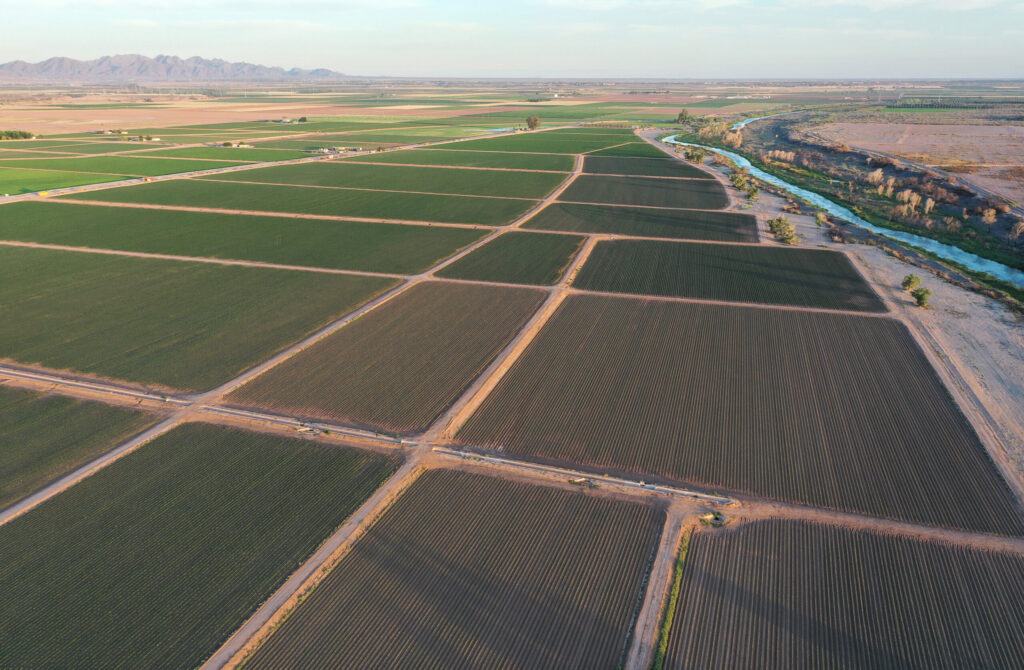
An aerial view of farmland which is irrigated by the water from the long-depleted Colorado River near Yuma, Arizona. (Photo by Mario Tama/Getty Images)
Amid stalled negotiations over how to manage the troubled Colorado River in the coming decades, the federal government offered clashing states four different management options for the river Wednesday.
The highly anticipated proposals released by the Bureau of Reclamation will serve as the foundation of new water management rules to replace the current ones set to expire in 2026.
Federal officials did not provide many details in their announcement, but all options included steep water cuts in Nevada, Arizona, and California.
Two options would require 3.5 million acre-feet of water cuts in Nevada, Arizona, and California annually, or enough water for about 6 million homes a year. One of the four options would impose as much as 4 million acres-feet of water conservation in the three states annually.
Nevada’s top water negotiator, John Entsminger, has long acknowledged that water use in the three lower basin states has outpaced the river’s supply and will need to be cut dramatically to ensure the long-term stability of the Colorado River and its reservoirs.
In a joint statement Entsminger, and representatives for the other lower basin states, said they would need time to evaluate the broad range of management options released by the federal government before throwing their weight behind any of them.
“The Lower Basin States of Arizona, California and Nevada remain committed to negotiating a path forward with all seven Colorado River states regarding the future operating guidelines for this critical river system,” the statement continued.
States along the Colorado River have been split into two camps for months over how to manage the river after 2026: Arizona, California, and Nevada in the lower basin; and Colorado, New Mexico, Utah and Wyoming in the upper basin.
Both camps submitted two competing plans to the federal government in March after states could not agree on how to share the river’s dwindling water supply after current rules expire.
In an effort to spur compromise, federal water managers also included a management option that blends components from both state plans.
Under the compromise proposal, Lake Powell could be required to release as much as 12 million acre-feet of water depending on the lake’s elevation. It would also require water cuts in both upper and lower basin states when reservoir storage falls to critically low levels, a suggestion in line with lower basin states’ proposal. The plan also requires the least water cuts for the lower basin states, a maximum of 2.1 million acre-feet.
But upper basin states have repeatedly taken a hard stance against mandatory reductions, arguing they already use less than their full share of the river.
Each basin is allocated 7.5 million acre-feet of water, for a total of 15 million acre-feet. However, lower basin states routinely use nearly all their 7.5 million acre-feet Colorado River allocation compared to the 4.5 million acres-feet used by the upper basin states. Today, officials acknowledge only 12.4 million acre-feet flows from the river each year, and flows continue to shrink due to climate change.
In a joint statement, water managers for the lower basin states said “it is imperative that the Upper and Lower Basin states continue working toward a negotiated solution that inherently requires the participation of all water users.”
Becky Mitchell, Colorado’s top water negotiator, said in a statement that Colorado is committed to the upper basin states’ proposed plan, which is designed to rebuild storage in the nation’s two largest reservoirs — Lake Mead and Lake Powell.
Still, all seven Colorado River basin states did manage to agree on a short-term proposal last year to conserve at least 3 million acre-feet of water through the end of 2026, while a new long-term plan is developed by the Bureau of Reclamation.
Those conservation measures have increased water elevation in Lake Mead by nearly 20 feet compared to two years ago, and have conserved more water in 2023 than any previous year since 1984. Lake Mead still has a long way to full recovery, sitting at 33% capacity as of Wednesday.
In 2021 and 2022, Lake Powell and Lake Mead both fell below critical thresholds, triggering emergency water cuts in Nevada, Arizona, and California and federal action to protect the reservoirs.
During a press call Wednesday, Bureau of Reclamation Commissioner Camille Touton said once the river’s short-term viability was settled by the short-term agreement her office turned their attention to the river’s long-term operations plan.
Touton noted the proposals introduced by Reclamation are based on several different proposals submitted by states, Native American Tribes, cooperating agencies, and non government organizations. The proposals do not include a Reclamation preferred alternative.
“These alternatives represent a responsible range from which to build the best and most robust path forward for the basin,” Touton said during a press call Wednesday. “There certainly are extremely difficult choices and tradeoffs to be made, but we believe that there are ample opportunities to create a fair path to solutions that work for the entire region.”
Reclamation will now analyze these alternatives to develop a draft Environmental Impact Statement (EIS). Once published, the draft EIS will include a public comment period. This puts Reclamation on a path to publish a final EIS, which would then be followed by a Record of Decision in 2026.

